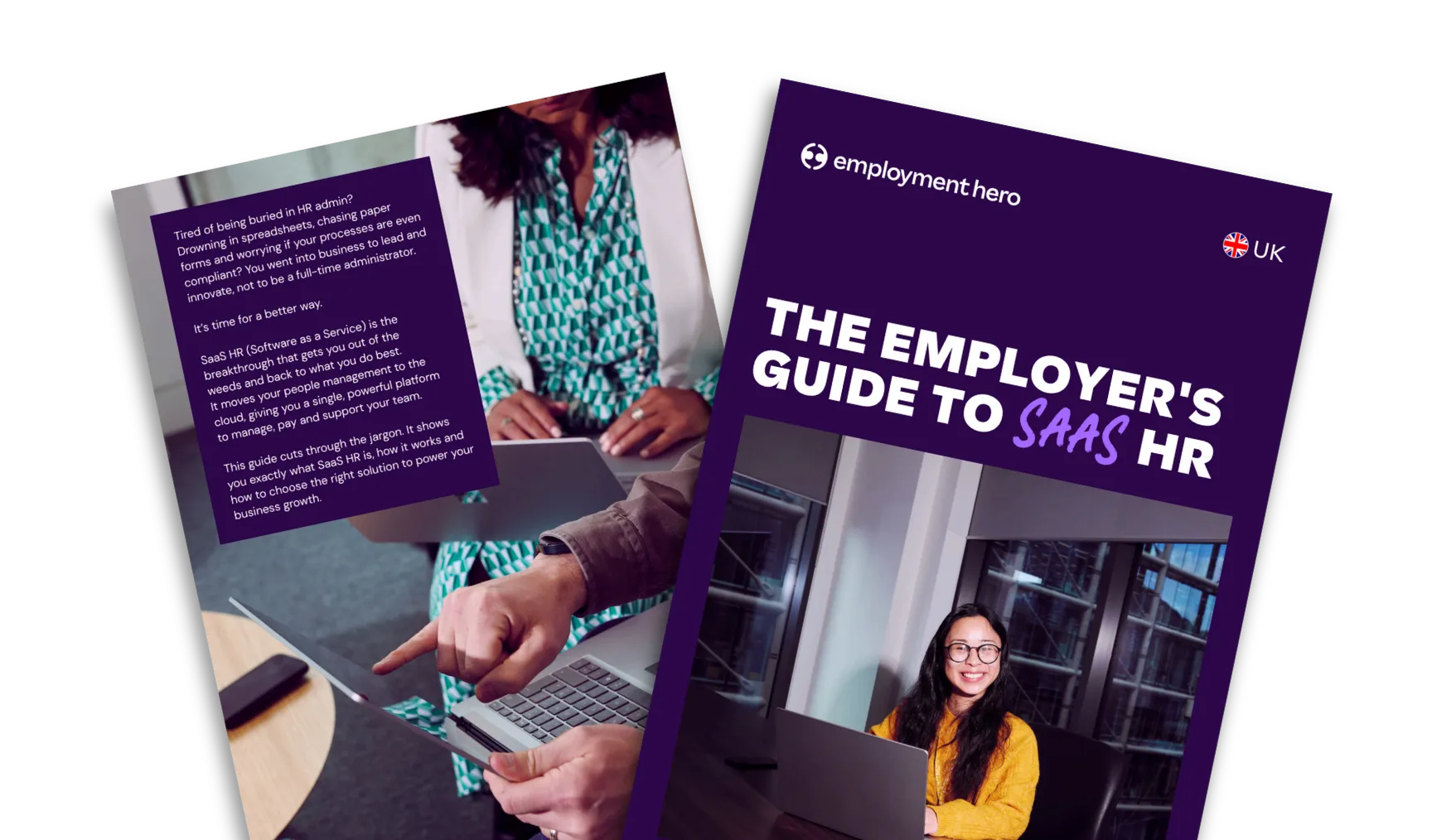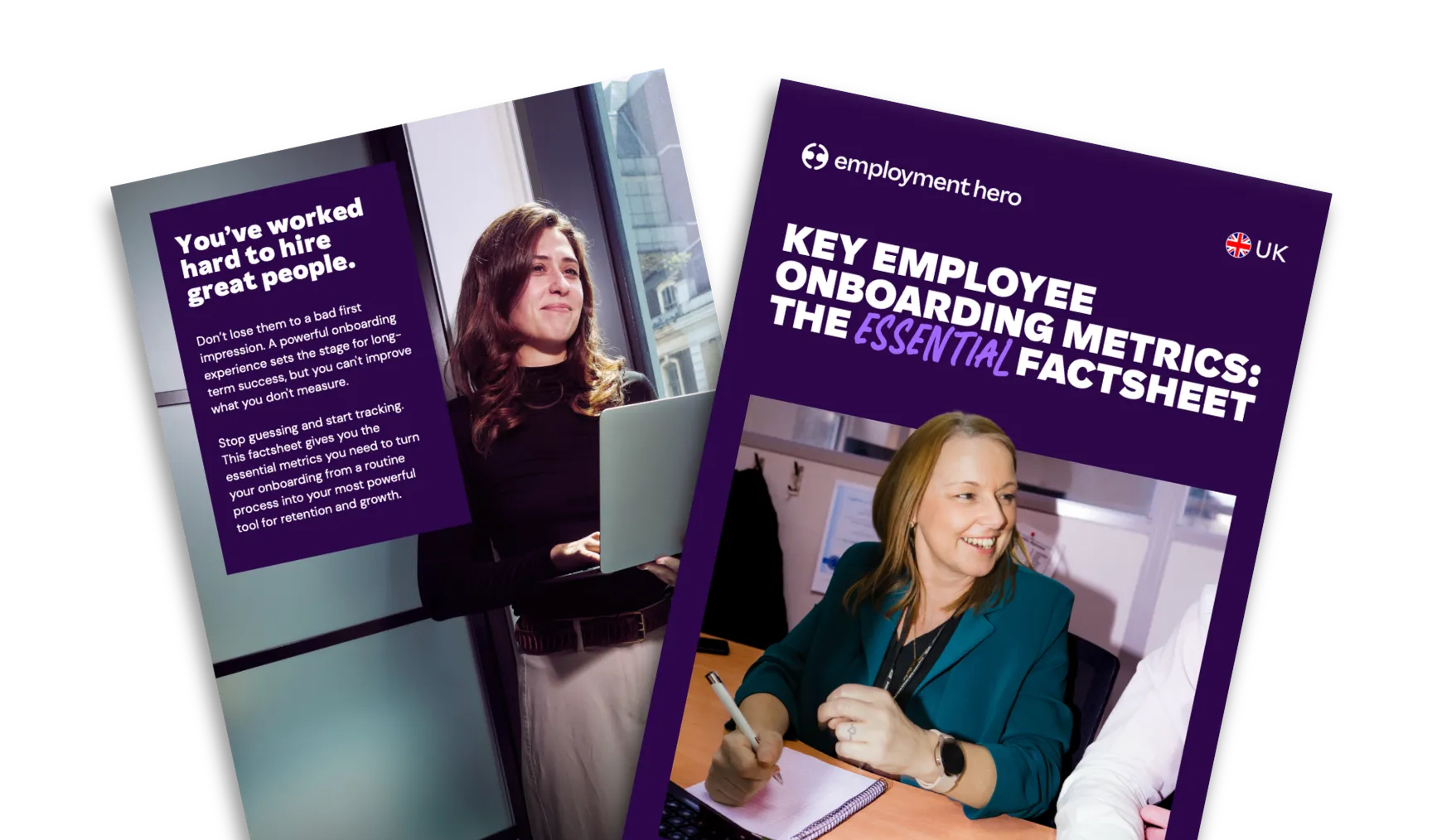The complete interview guide for hiring managers
Published
The complete interview guide for hiring managers
Published
1 min read
The interview process is broken. We know this because according to our Work That Works report 3 in 4 business leaders say recruitment is a challenge. The reality is that too many interviews are unstructured, biased and ultimately fail to predict which candidate will actually succeed. Relying on gut feelings, vague questions and inconsistent processes isn’t just bad practice, it’s a high-risk gamble that costs you time, money and top talent. In fact, according to Employment Hero’s research, 6 in 10 businesses say they’ve had issues with making the wrong hiring decision before.
Employment Hero wants to put a stop to all of that. So it’s time to stop improvising and start leading with a proven system. A great interview isn’t a casual chat; it’s a strategic assessment designed to uncover true potential, mitigate bias and build a winning team.
This interview guide for hiring managers is your playbook for running fair, effective and legally compliant interviews that deliver results.
Understanding workplace diversity
Building a diverse team isn’t about meeting quotas or ticking boxes, it’s about building strength. Diversity drives innovation, resilience and smarter decision-making. When teams bring together different experiences and perspectives, they solve problems more creatively and connect more deeply with customers. Prioritising diversity isn’t just the right thing to do, it’s a powerful competitive advantage.
Creating that advantage starts with intention. Building a truly diverse team requires a thoughtful, strategic approach to how you hire.
Diversity hiring strategies
The reality is, inclusive hiring doesn’t happen by accident. It’s the result of designing recruitment processes that give every candidate a fair chance to shine. That means using gender-neutral language in job descriptions, promoting roles across diverse channels and standardising interviews so every applicant is assessed against clear, objective criteria.
It also means equipping your hiring managers with the tools and training to recognise and challenge unconscious bias. Because awareness is the first step toward taking action, and through action, we create workplaces where everyone can thrive.
Reducing bias in your hiring decisions
Unconscious biases are mental shortcuts that cause us to make snap judgments about people based on factors like their age, gender or background. In an interview, these biases can lead you to favour candidates who are “like you,” rather than the person who is most qualified for the role.
The most powerful way to combat this is through structured interviews. This means asking every candidate for a role the same set of predetermined questions and scoring their answers against a consistent rubric. This data-driven approach forces you to evaluate candidates on their skills and experience, not on a vague sense of “culture fit.” For an even more robust system, use our hiring interview checklists to standardise your process.
A key tool for this is a preparation worksheet.
What is an interview prep worksheet?
An interview prep worksheet is a template used to plan your interview before the candidate walks in the door. It forces you to define the key competencies for the role and prepare specific, relevant questions to assess them. Using a worksheet for every interview ensures consistency, helps you stay on track and provides a clear record of your evaluation process. It turns an unstructured conversation into a systematic assessment.
With this preparation in place, you can focus on conducting a professional and engaging interview.
Interview dos and don’ts
| Do | Don’t |
| Prepare thoroughly by reviewing the candidate’s CV and your interview worksheet. | Wing it. An unstructured interview is a breeding ground for bias. |
| Start the interview by building rapport and explaining the structure of the conversation. | Ask illegal or inappropriate questions. |
| Listen more than you talk. Your goal is to get the candidate to share evidence of their skills. | Let one strong (or weak) answer colour your perception of the entire interview. |
Take detailed notes to help you remember key details and evaluate fairly. | Make promises you can’t keep about salary, benefits or progression. |
| Sell the role and the company. The interview is a two-way street. | Forget to leave time for the candidate to ask their own questions. |
Legal don’ts when speaking with a candidate
In the UK, the Equality Act 2010 protects candidates from discrimination based on nine “protected characteristics,” including age, disability, gender reassignment, marriage and civil partnership, pregnancy and maternity, race, religion or belief, sex and sexual orientation. Asking questions related to these areas, even innocently, can expose your business to legal risk. You also have obligations under GDPR to handle candidate data securely.
Questions to avoid
Never ask questions about:
- A candidate’s age or date of birth.
- Their marital status, plans for children or childcare arrangements.
- Their nationality or country of origin (you can ask if they have the right to work in the UK).
- Any disabilities or health conditions, unless it’s to discuss reasonable adjustments.
- Their religion or political beliefs.
To stay on safe ground, focus your questions on the candidate’s ability to do the job. The best way to do this is through behavioural interviewing.
Behavioural interviewing
Behavioural interviewing is a technique based on the principle that past performance is the best predictor of future performance. Instead of asking hypothetical questions (“What would you do if…?”), you ask candidates to provide specific examples of how they have handled situations in the past. This is a core part of assessing a candidate’s soft skills. See our guide on behavioural interviewing for soft skills for more detail.
The STAR method
The STAR method is a simple and powerful tool for structuring behavioural interview answers. When a candidate responds to your question, listen for these four elements:
- Situation: The context. What was the situation they were in?
- Task: What was their specific responsibility or goal?
- Action: What specific actions did they take to address the situation?
- Result: What was the outcome of their actions? What did they achieve?
If a candidate’s answer is missing any of these elements, prompt them for more detail (e.g., “And what was the result of that?”). This ensures you get the concrete evidence you need to make a fair assessment. For more ideas on what to ask, explore these common job interview questions with answers.
Pacing the interview
A well-paced interview feels like a professional and engaging conversation, not an interrogation. Start with some rapport-building and an introduction to the agenda. Move into your core behavioural questions and make sure you leave at least 10-15 minutes at the end for the candidate to ask their questions. Respect the candidate’s time by starting and finishing promptly.
This is especially important in a remote setting.
Video interviewing dos and don’ts
Video interviews are now standard practice, but they come with their own set of rules.
| Do | Don’t |
| Test your technology beforehand. | Conduct the interview in a noisy or distracting environment. |
| Ensure you have a professional background and good lighting. | Assume the candidate is familiar with your chosen video platform. |
| Look at the camera, not at your own image, to create a sense of eye contact. | Forget about data security. Ensure your interviews are conducted on a secure platform. |
| Look at the camera, not at your own image, to create a sense of eye contact. | Look at your own image, away from your camera or avoid eye contact. |
| Be extra clear in your communication to compensate for the lack of physical cues. For remote roles, use our list of 101 remote interview questions. | Use vague or ambiguous language. Without body language cues, it’s easy for messages to be misunderstood. |
After the interview
Your post-interview process is just as important as the interview itself. Use a standardised evaluation form to score each candidate against the predetermined competencies immediately after the interview, while the details are still fresh.
Follow up with every candidate in a timely manner to let them know the outcome. A positive candidate experience, even for those you reject, is crucial for your employer brand. For the successful candidate, this is where a smooth transition to your onboarding software begins.
10 interview tips for new hiring managers
Hiring the right person is one of the most important decisions you’ll make as a manager. At Employment Hero, we believe great hiring is about preparation, consistency and fairness, not gut instinct. Here’s how to run confident, structured interviews that help you find (and win) the best talent.
1. Define the role
Before you post a job ad, take the time to define what success looks like in the role. What will this person achieve in their first six months? What skills, experience and mindset will help them succeed? A clear role profile helps you write better job descriptions, ask sharper questions and attract the right candidates from the start.
2. Prepare, prepare, prepare
Never walk into an interview without a plan. Review the candidate’s application, revisit the job brief and know exactly what you need to learn from the conversation. Preparation shows respect for the candidate’s time and ensures you get meaningful insights that support good decision-making.
3. Use a scorecard
Structured, consistent assessment is the key to fair and effective hiring. Create a scorecard aligned to the core competencies of the role — such as communication, problem-solving or leadership — and rate each candidate using the same criteria. This keeps your decision objective and focused on evidence, not impressions.
4. Ask open-ended questions
Avoid “yes” or “no” questions that limit the conversation. Instead, ask open-ended prompts like:
- “Tell me about a time when…”
- “How did you handle…”.
These encourage candidates to share examples that reveal their thinking, approach and real-world experience.
5. Dig for STAR evidence
Use the STAR method (Situation, Task, Action, Result) to guide your questioning. If a candidate gives a vague answer, prompt them for detail:
- What was the situation?
- What was your specific role or task?
- What actions did you take?
- What was the outcome?
This structured technique helps you uncover clear, measurable evidence of capability.
6. Take notes
Record key facts, quotes and examples, not subjective impressions. Avoid writing things like “seems confident” or “not sure they’d fit the culture.” Instead, focus on observable behaviours and evidence that align (or don’t align) with your scorecard. These notes will be critical when you’re comparing candidates later.
7. Be a brand ambassador
Remember, every interview is a two-way conversation. The candidate is assessing you and your organisation as much as you’re assessing them. Showcase what makes your team and company special, your mission, culture and growth opportunities. A positive candidate experience can strengthen your employer brand, even for those who don’t get the job.
8. Listen actively
Interviews are about learning, and that means listening more than talking. Give candidates space to share their stories, avoid interrupting and show genuine curiosity. Active listening helps you uncover insights you might otherwise miss and builds rapport that puts candidates at ease.
9. Leave time for questions
Great candidates come prepared with thoughtful questions. This is your opportunity to understand what matters to them, their values, motivations and expectations. The questions they ask can be just as telling as the answers they give.
10. Trust the process, not your gut
Your intuition might be useful, but it’s no substitute for data. Use your scorecards, notes and structured process to guide your final decision. Evidence-based hiring not only reduces bias, it leads to better hires and stronger teams.
Download the full interview guide
Hiring the right people is the most important job of any leader. So stop leaving it to chance. It’s time to build a rigorous, fair and effective process that allows you to identify and hire the talent your business needs to win. Employment Hero are here to help and you’ll find everything you need to put together a bullet-proof interview in our guide.
Register for the guide
Related Resources
-
 Read more: Onboarding Automation: Redefine Your Process With AI
Read more: Onboarding Automation: Redefine Your Process With AIOnboarding Automation: Redefine Your Process With AI
Discover how AI-powered onboarding automation can transform your employee onboarding process. Learn the benefits, challenges and key tasks to automate.
-
 Read more: What is SaaS HR? A comprehensive guide
Read more: What is SaaS HR? A comprehensive guideWhat is SaaS HR? A comprehensive guide
Learn what SaaS HR means, how it works, and why UK employers are switching to cloud-based HR software to streamline…
-
 Read more: Key Employee Onboarding Metrics and KPIs to Track
Read more: Key Employee Onboarding Metrics and KPIs to TrackKey Employee Onboarding Metrics and KPIs to Track
Discover the top onboarding metrics and KPIs every UK employer should track, and how to measure the success of your…



















